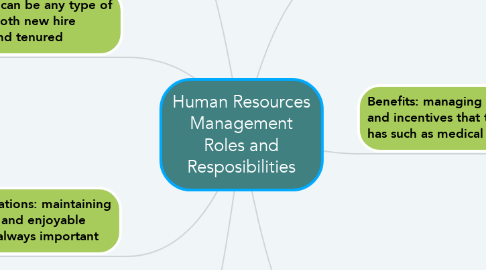Human Resources Management Roles and Resposibilities
by Ian Schnell

1. Payroll: this can be done by human resources but some times has a dedicated team member assigned
1.1. This is always a big topic with any company so making sure that all the employees pay is accurate and fair is key
1.2. Wages and salaries will be reviewed by human resources to make sure it is fair across the board and meets the companies needs
1.3. When ever there is an issue that effects an employees pay amount they will be referred to human resources to look at their pay stubs and correct or advise the employee about their pay
2. Benefits: managing the benefits and incentives that the company has such as medical or dental
2.1. The benefits that a company offers can be a big reason that a person may choose to apply to a job or keep them around
2.2. Human resource will look to create benefit packages that will be good for the company but also suits the employees needs. Such as, if the company can offer a dental insurance or if they want to offer a better medical insurance to keep them employees happy and healthy
2.3. Other items can include incentives for the employees. This can be something as simple as bonuses and how those would be done such as a performance review
3. Recruiting: also known as talent acquisition, will seek out qualified job seekers
3.1. Human resources will go through applications and search for the best candidates that they need for the company
3.2. Once human resources finds qualified candidates for the job they will have them go through the interview process to determine if they will be a good fit for the company
3.3. Once they have made their final decision on who they will hire, they will on board them into the company and provide them an offer letter for the job
4. Training: this can be any type of training for both new hire employees and tenured
4.1. Human resource managers will make up and develop the various types of training that a new hire employee should know about their job
4.2. After they have been recruited human resources ensures that the training is going well for the new hire employee until they hit production
4.3. The training also varies from new hire training to recurring training which can either be for the specific job or training to remind employees about specific company policies
5. Employee Relations: maintaining a happy, safe, and enjoyable work place is always important
5.1. Whether there is a disgruntled employee, a dispute between employees, or improving employee relations, human resources needs to manage these types of interactions
5.2. This can always be a stressful part of the job when trying to satisfy the needs of the employees while trying to be a safe medium for both parties
5.3. Human resources will help the company by promoting healthy and friendly relations between employees and will help to resolves any issues that arise
6. Employee Performance: Performance reviews are a way to ensure that all employees are performing to their best
6.1. Human resources will conduct employee performance reviews and make recommendations on how to boost morale and performance
6.2. Ensuring the company is running smoothly is imperative. The performance of each employee can be tracked and monitored to make sure that the goals of the company are being met
6.3. Knowing how the employees are performing can allow management to create action plans to drive performance and morale in a positive direction and can lead to employee incentives for doing a good job
7. Company Policies: human resources is key in enforcing and interpreting company policies
7.1. Ensuring that everyone follows, understands, and know the company policies helps to keep the work environment safe and productive
7.2. While every member of management to lowest level employee are all there to follow the policies there are times where a rule or policy is broken. Human resources then needs to help step in and determine what rule was broken and how
7.3. After determining what policy was broken, they then need to determine the appropriate level of corrective action that should be taken and interpret the policy.


